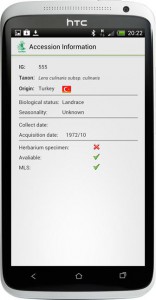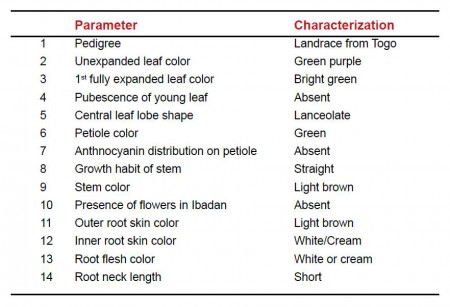- Ruth deconstructs her local tomatoes.
- New Mexico State University reaches out to CATIE’s genebank.
- Montana gets a genebank.
- Long Cymie Payne UBerkeley lecture on international law and biodiversity.
- Milking the data.
- Speaking of milk, indigenous lassi probiotics isolated, sequenced and deposited in genebank.
Is there more than one TME 419 cassava?
The TME 419 cassava that I Nibbled about earlier today has been making quite a splash in both DR Congo and Nigeria. Question is, is it TME 419?
Those who know about such things will recognize TME as an IITA genebank number. And indeed, if you look it up either on Genesys or IITA’s genebank database, you land on a Togolese landrace called Gbazekoute. Unfortunately, that doesn’t look anything like the TME 419 described in IITA’s Improved Cassava Variety Handbook. 1 There, TME 419 is indeed a Togolese landrace, but with the following characteristics: 2
Compare that with the description in the IITA database. Is the shape of the leaf’s central lobe lanceolate or elliptic? Is there or is there not pigmentation on the petiole? Is the colour of the root pulp white/cream or yellow? And does it have a purple cortex or not? A discrepancy in one of these descriptors I might have understood, but it is clear to me that we’re talking here about quite different cassavas.
So I ask IITA: which one is the real TME 419? I mean the one making news in DR Congo and Nigeria.
Nibbles: AVRDC, PPB, Local foods, Emergency food, AnGR meeting, Tilapia, Agave, Asses, New cassava, Diversity for services, Climate change and phenology
- 40 years of AVRDC celebrated. Lots more stuff on vegetables below, so stick around if that grabbed you.
- Breeding with farmers, an ICARDA manual. Are there any examples with vegetables, I wonder?
- Let’s Go Local! See the ABC piece before it disappears from the front page. But it’s not just karat bananas that you need, of course.
- Going local in Philippines too. And India for that matter. And, ahem, Arkansas. Oh and Amazonia.
- Another use for baobab. I feel a factsheet coming on.
- And here are some utterly different fruits.
- Talking AnGR in Latin America.
- GIFT tilapia in India! Look it up, we did a Brainfood on it.
- A Belgian milestone. Put out more flags.
- Is it Cinco de Mayo yet? Well, break out the tequila anyway.
- Is it World Donkey Day yet?
- “Farmer associations hope TME 419 will soon spread across the whole country.” That would be a fancy new cassava in DRC. Anybody worried about that at all?
- Plant diversity key to zzzzzzzzzz…
- Well this will wake you up.
Genebank database hell goes mobile
 With a mighty leap, the ICARDA genebank has just landed squarely in the 21st century. You can now download an app and search the international collection managed by the centre from your Android phone. iPhone version coming soon. If you test it out, leave your comments here and they will reach the relevant ICARDA geek.
With a mighty leap, the ICARDA genebank has just landed squarely in the 21st century. You can now download an app and search the international collection managed by the centre from your Android phone. iPhone version coming soon. If you test it out, leave your comments here and they will reach the relevant ICARDA geek.
Nibbles: Acorn harvest video, NordGen news, Kolkata Seed Festival, Peopling the Planet, Rye, Ancient Roman diet
- From little acorns…
- Thanks for sharing, NordGen!
- Thanks for sharing, Kolkata!
- Nature special issue on Peopling the Planet.
- Rye soundbites.
- How to eat like a Roman.
- Videos on India’s pastoralists.
